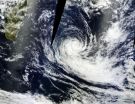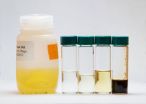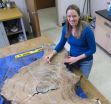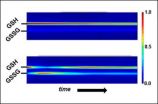(Press-News.org) Tropical Cyclone Fobane continues to be battered with increasing vertical wind shear as it moves southward through the Southern Indian Ocean. NASA's Aqua satellite passed overhead and saw the bulk of precipitation and bands of thunderstorms were south of the center.
On Feb. 12 at 0900 UTC/4 a.m. EST, Tropical Cyclone Fobane had maximum sustained winds near 45 knots/51.7 mph/83.3 kph. Fobane was centered near 27.6 south latitude and 64.7 east longitude, about 596 nautical miles southeast of Port Louis, Mauritius. Fobane is moving to the south-southwest at 11 knots/12.6 mph/20.3 kph.
The Moderate Resolution Imaging Spectroradiometer or MODIS instrument aboard NASA's Aqua satellite captured a visible image of Tropical Cyclone Fobane on Feb. 12 at 0530 UTC/12:30 a.m. EST as it continued spinning down in the Southern Indian Ocean. The image showed a tightly-wrapped core and still appears well-organized. Bands of strong thunderstorms appear in the southwestern quadrant of the storm.
The Joint Typhoon Warning Center or JTWC looked at features stacked over Fobane in different layers of the atmosphere. JTWC noted that an upper level low pressure area embedded in a mid-latitude trough (elongated area of low pressure) is situated over Fobane's low-level center. Because of that upper-level low, convection and thunderstorm development has been stifled over the last day and a half, as it has created strong vertical wind shear between 20 to 30 knots/23.0 to 34.5 mph/37.0 to 55.5 kph) near the low-level center of Fobane. In addition to the upper-level atmospheric cocktail weakening Fobane, the storm is also moving into cooler sea surface temperatures which will weaken it more.
The JTWC expects Fobane to dissipate in the next couple of days.
INFORMATION:
Text credit: Rob Gutro
NASA's Goddard Space Flight Center
NASA satellite sees Tropical Cyclone Fobane spinning down
2014-02-12
ELSE PRESS RELEASES FROM THIS DATE:
Study highlights long-term effects of childhood obesity on late-life health
2014-02-12
Childhood obesity rates have nearly tripled in the previous 30 years and researchers are asking the important question of how this epidemic will impact the future health of these obese children and public health in general. A University of Colorado Cancer Center article recently published in the journal Gerontology shows that even in cases in which obese children later lose weight, the health effects of childhood obesity may be long-lasting and profound.
"There were two things going on here. First, the earlier you are exposed to obesity, the earlier we may see the onset ...
Study: IOC should ban lead shot to help wildlife, water
2014-02-12
With the world watching the Sochi Winter Olympics including the biathlon shooting events, now is the time for the International Olympic Committee (IOC) to ban the use of lead shot to prevent wildlife poisoning and health threats to surface and groundwater, says a new paper co-authored this month by a University of Guelph biologist.
Thousands of tons of lead shot discharged every year during training by Olympic shooters pose a threat to birds and mammals and to water resources, says Vernon Thomas, professor emeritus in the Department of Integrative Biology.
His paper ...
Plastic shopping bags make a fine diesel fuel, researchers report
2014-02-12
CHAMPAIGN, Ill. — Plastic shopping bags, an abundant source of litter on land and at sea, can be converted into diesel, natural gas and other useful petroleum products, researchers report.
The conversion produces significantly more energy than it requires and results in transportation fuels – diesel, for example – that can be blended with existing ultra-low-sulfur diesels and biodiesels. Other products, such as natural gas, naphtha (a solvent), gasoline, waxes and lubricating oils such as engine oil and hydraulic oil also can be obtained from shopping bags.
A report ...
LA BioMed researchers report on promising new therapy for devastating genetic disorder
2014-02-12
LOS ANGELES – (Feb. 12, 2014) – A promising new therapy has – for the first time – reduced damage to the brain that can be caused by Sanfilippo B (MPS IIIB), a rare and devastating genetic disease, Los Angeles Biomedical Research Institute (LA BioMed) researchers will report today in a presentation at the Lysosomal Disease Network's 10th Annual WORLD Symposium™.
Sanfilippo B syndrome is a lysosomal storage disease belonging to the group of mucopolysaccharidoses (MPS) that is characterized by severe and rapid intellectual deterioration. LA BioMed pioneered the research ...
From artificial to natural, the food industry makes a major shift
2014-02-12
Extracts from algae, rosemary and monk fruit could soon replace synthetic ingredients and food additives such as Blue No. 1, BHT and aspartame that label-conscious grocery shoppers are increasingly shunning. Research is enabling this shift from artificial colors, sweeteners and preservatives to naturally derived ones, and could soon yield many more natural options, reports Chemical & Engineering News, the weekly newsmagazine of the American Chemical Society.
Melody M. Bomgardner, senior editor at C&EN, notes that the trend has built momentum as concern over negative ...
Help for a scarred heart: Scarring cells turned to beating muscle
2014-02-12
ANN ARBOR – Poets and physicians know that a scarred heart cannot beat the way it used to, but the science of reprogramming cells offers hope--for the physical heart, at least.
A team of University of Michigan biomedical engineers has turned cells common in scar tissue into colonies of beating heart cells. Their findings could advance the path toward regenerating tissue that's been damaged in a heart attack.
Previous work in direct reprogramming, jumping straight from a cell type involved in scarring to heart muscle cells, has a low success rate. But Andrew Putnam, ...
San Francisco's big 1906 quake was third of a series on San Andreas Fault
2014-02-12
EUGENE, Ore. -- (Feb. 12, 2014) -- Research led by a University of Oregon doctoral student in California's Santa Cruz Mountains has uncovered geologic evidence that supports historical narratives for two earthquakes in the 68 years prior to San Francisco's devastating 1906 disaster.
The evidence places the two earthquakes, in 1838 and 1890, on the San Andreas Fault, as theorized by many researchers based on written accounts about damage to Spanish-built missions in the Monterey and San Francisco bay areas. These two quakes, as in 1906, were surface-rupturing events, the ...
Clever NIST/JPL technology decodes more information from single photons
2014-02-12
It's not quite Star Trek communications—yet. But long-distance communications in space may be easier now that researchers at the National Institute of Standards and Technology (NIST) and Jet Propulsion Laboratory (JPL) have designed a clever detector array that can extract more information than usual from single particles of light.
Described in a new paper,* the NIST/JPL array-on-a-chip easily identifies the position of the exact detector in a multi-detector system that absorbs an incoming infrared light particle, or photon. That's the norm for digital photography cameras, ...
New NIST method evaluates response to oxidation in live cells
2014-02-12
Researchers at the National Institute of Standards and Technology (NIST) have developed a new method for accurately measuring a key process governing a wide variety of cellular functions that may become the basis for a "health checkup" for living cells.
The NIST technique measures changes in a living cell's internal redox (reduction-oxidation) potential, a chemistry concept that expresses the favorability of reactions in which molecules or atoms either gain or lose electrons. Redox reactions are important to cell chemistry because they regulate many genes and the proteins ...
Popular disinfectants do not kill HPV
2014-02-12
Commonly used disinfectants do not kill human papillomavirus (HPV) that makes possible non-sexual transmission of the virus, thus creating a need for hospital policy changes, according to researchers from Penn State College of Medicine and Brigham Young University.
"Because it is difficult to produce infectious HPV particles for research, little has been known about HPV susceptibility to disinfection," said Craig Meyers, Distinguished Professor of Microbiology and Immunology, Penn State College of Medicine.
Use of disinfectants on HPV in health care settings has been ...




